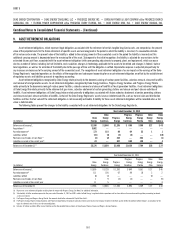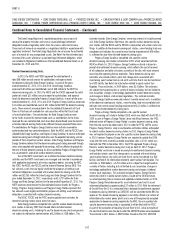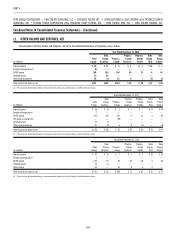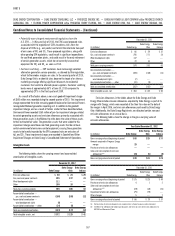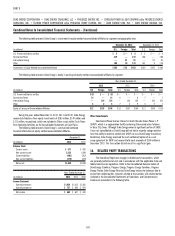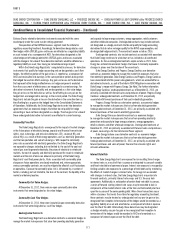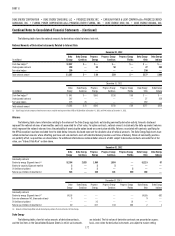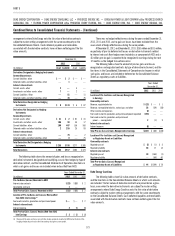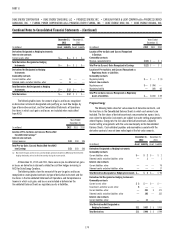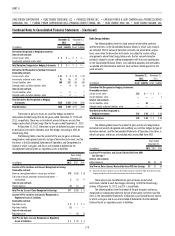Duke Energy 2012 Annual Report Download - page 191
Download and view the complete annual report
Please find page 191 of the 2012 Duke Energy annual report below. You can navigate through the pages in the report by either clicking on the pages listed below, or by using the keyword search tool below to find specific information within the annual report.
171
PART II
DUKE ENERGY CORPORATION • DUKE ENERGY CAROLINAS, LLC • PROGRESS ENERGY, INC. • CAROLINA POWER & LIGHT COMPANY d/b/a PROGRESS ENERGY
CAROLINAS, INC. • FLORIDA POWER CORPORATION d/b/a PROGRESS ENERY FLORIDA, INC. • DUKE ENERGY OHIO, INC. • DUKE ENERGY INDIANA, INC
.
Combined Notes to Consolidated Financial Statements – (Continued)
Balance Sheets related to derivative instruments executed with the same
counterparty under the same master netting agreement.
The operations of the USFE&G business segment meet the criteria for
regulatory accounting treatment. Accordingly, for derivatives designated as cash
fl ow hedges within USFE&G, gains and losses are refl ected as a regulatory liability
or asset instead of as a component of AOCI. For derivatives designated as fair
value hedges or left undesignated within USFE&G, gains and losses associated
with the change in fair value of these derivative contracts would be deferred as a
regulatory liability or asset, thus having no immediate earnings impact.
Within the Duke Energy Registrants’ unregulated businesses, for derivative
instruments that qualify for hedge accounting and are designated as cash fl ow
hedges, the effective portion of the gain or loss is reported as a component of
AOCI and reclassifi ed into earnings in the same period or periods during which
the hedged transaction affects earnings. Any gains or losses on the derivative
that represent either hedge ineffectiveness or hedge components excluded
from the assessment of effectiveness are recognized in current earnings. For
derivative instruments that qualify and are designated as a fair value hedge,
the gain or loss on the derivative as well as the offsetting loss or gain on the
hedged item are recognized in earnings in the current period. The Duke Energy
Registrants include the gain or loss on the derivative in the same line item as
the offsetting loss or gain on the hedged item in the Consolidated Statements
of Operations. Additionally, the Duke Energy Registrants enter into derivative
agreements that are economic hedges that either do not qualify for hedge
accounting or have not been designated as a hedge. The changes in fair value of
these undesignated derivative instruments are refl ected in current earnings.
Commodity Price Risk
The Duke Energy Registrants are exposed to the impact of market changes
in the future prices of electricity (energy, capacity and fi nancial transmission
rights), coal, natural gas and emission allowances (SO2, seasonal NOX and
annual NOX) as a result of their energy operations such as electricity generation
and the transportation and sale of natural gas. With respect to commodity
price risks associated with electricity generation, the Duke Energy Registrants
are exposed to changes including, but not limited to, the cost of the coal and
natural gas used to generate electricity, the prices of electricity in wholesale
markets, the cost of capacity and electricity purchased for resale in wholesale
markets and the cost of emission allowances primarily at the Duke Energy
Registrants’ coal fi red power plants. Risks associated with commodity price
changes on future operations are closely monitored and, where appropriate,
various commodity contracts are used to mitigate the effect of such fl uctuations
on operations. Exposure to commodity price risk is infl uenced by a number of
factors, including, but not limited to, the term of the contract, the liquidity of the
market and delivery location.
Commodity Fair Value Hedges.
At December 31, 2012, there were no open commodity derivative
instruments that were designated as fair value hedges.
Commodity Cash Flow Hedges.
At December 31, 2012, there were immaterial open commodity derivative
instruments that were designated as cash fl ow hedges.
Undesignated Contracts.
The Duke Energy Registrants use derivative contracts as economic hedges to
manage the market risk exposures that arise from providing electricity generation
and capacity to large energy customers, energy aggregators, retail customers
and other wholesale companies. Undesignated contracts may include contracts
not designated as a hedge, contracts that do not qualify for hedge accounting,
derivatives that do not or no longer qualify for the NPNS scope exception, and
de-designated hedge contracts. These contracts expire as late as 2016.
Undesignated contracts also include contracts associated with operations
that Duke Energy continues to wind down or has included as discontinued
operations. As these undesignated contracts expire as late as 2021, Duke
Energy has entered into economic hedges that leave it minimally exposed to
changes in prices over the duration of these contracts.
Duke Energy Carolinas and Progress Energy Carolinas use derivative
contracts as economic hedges to manage the market risk exposures that arise
from electricity generation. Duke Energy Carolinas and Progress Energy Carolinas
have also entered into fi rm power sale agreements, which are accounted for as
derivative instruments, as part of the Interim FERC Mitigation in connection with
Duke Energy’s merger with Progress Energy. See Note 2 for further information.
Duke Energy Carolinas’ undesignated contracts as of December 31, 2012, are
primarily associated with forward sales and purchases of power. Progress Energy
Carolinas’ undesignated contracts as of December 31, 2012, are primarily
associated with forward purchases of fuel used in electricity generation.
Progress Energy Florida uses derivative contracts as economic hedges
to manage the market risk exposures that arise from electricity generation.
Undesignated contracts at December 31, 2012, are primarily associated with
forward purchases of fuel used in electricity generation.
Duke Energy Ohio uses derivative contracts as economic hedges
to manage the market risk exposures that arise from providing electricity
generation and capacity to large energy customers, energy aggregators,
retail customers and other wholesale companies. Undesignated contracts at
December 31, 2012 are primarily associated with forward sales and purchases
of power, coal and gas for the Commercial Power segment.
Duke Energy Indiana uses derivative contracts as economic hedges
to manage the market risk exposures that arise from electricity generation.
Undesignated contracts at December 31, 2012, are primarily associated with
forward purchases and sales of power, fi nancial transmission rights and
emission allowances.
Interest Rate Risk
The Duke Energy Registrants are exposed to risk resulting from changes
in interest rates as a result of their issuance or anticipated issuance of variable
and fi xed-rate debt and commercial paper. Interest rate exposure is managed by
limiting variable-rate exposures to a percentage of total debt and by monitoring
the effects of market changes in interest rates. To manage risk associated
with changes in interest rates, the Duke Energy Registrants may enter into
fi nancial contracts; primarily interest rate swaps and U.S. Treasury lock
agreements. Additionally, in anticipation of certain fi xed-rate debt issuances,
a series of forward starting interest rate swaps may be executed to lock in
components of the market interest rates at the time and terminated prior to or
upon the issuance of the corresponding debt. When these transactions occur
within a business that meets the criteria for regulatory accounting treatment,
these contracts may be treated as undesignated and any pre-tax gain or loss
recognized from inception to termination of the hedges would be recorded as a
regulatory liability or asset and amortized as a component of interest expense
over the life of the debt. Alternatively, these derivatives may be designated
as hedges whereby, any pre-tax gain or loss recognized from inception to
termination of the hedges would be recorded in AOCI and amortized as a
component of interest expense over the life of the debt.


